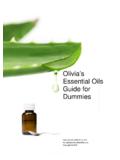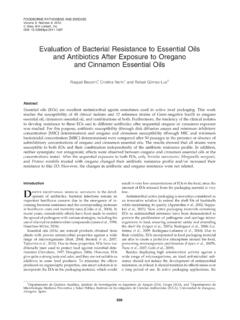Transcription of Extraction of Essential Oils from Spices using Steam ...
1 RCarbonRExtraction of Essential oils from Spices using Steam DistillationCarbonRCarbonContents Objectives 1 Introduction 1 Extraction of trans-anethole from star anise 2 Extraction of trans-cinnamaldehyde from cinnamon 5 Manuscript prepared by Dr. Almas I. Zayya, Dr. A. Jonathan Singh and Dr. Hemi Cumming. School of Chemical and Physical Sciences, Victoria University of Wellington, New of the aroma and flavour components from dried plant materials is one of the oldest chemical operations developed by humankind.
2 The preparation of a cup of tea or coffee is an everyday example of extracting the flavour and aroma components, including the stimulant caffeine, with hot water. In the following experiments, Steam distillation is used to extract the Essential oils from two common Spices : star anise and cinnamon bark (Figure 1). The main Essential oils responsible for the aroma and flavour of these Spices are trans-anethole [1-methoxy-4-(1-propenyl)benzene] from star anise and trans-cinnamaldehyde [(2E)-3-phenylprop-2-enal] from cinnamon distillation is a technique used to distill immiscible liquids, for which Steam provides one of the immiscible The two substances mix in the gas phase and co-distill, but when cooled the desired component separates from water as it is immiscible.
3 Steam distillation is commonly used to extract perfume and flavour oils from natural 1. Essential oils to be extracted from Spices : trans-anethole from star aniseand trans-cinnamaldehyde from The principal aims of these experiments are to provide experience in the Extraction of Essential oils from Spices using the Steam distillation technique. Students will isolate and purify the key chemical compounds that contribute to the aroma and flavour of the Spices . The compounds will then be characterised by NMR spectroscopy using the benchtop Spinsolve NMR of trans-anethole from star anise A macroscale direct method for Steam distillation is used to extract the Essential oil, which is composed primarily of trans-anethole, from the star anise spice.
4 In this method, the Steam is generated in situ by heating the ground dry spice material and water in the distillation flask (Figure 2). SafetyDiethyl ether is highly flammable, handle with caution. Magnesium sulfate is hazardous with respect to ingestion, inhalation and skin contact. Deuterochloroform (CDCl3) is toxic, handle with caution and do not ingest or inhale. Figure 3. Ground whole star anise seed 2. Direct method Steam distillation Calculate the yield of trans-anethole from the dry mass of the seed pods. Record the 1H NMR and COSY spectra of trans- anethole using the Spinsolve NMR spectrometer.
5 Prepare the NMR sample using a drop of the oil in mL of CDCl3. Assign the 1H NMR and COSY spectra to the structure of Grind two whole star anise seed pods (approximately g) in a mortar and pestle (Figure 3), and place the ground material into a 100 mL 2-neck round bottom flask. Add water (40 mL) and begin the distillation . After collecting about 20 mL of cloudy distillate, add more water (20 mL) into the distillation flask from the dropping funnel. Collect a further 20 mL of distillate then stop the distillation . Combine the distillates in a separatory funnel and extract with diethyl ether (2 20 mL).
6 Dry the ethereal layer with anhydrous magnesium sulfate and filter the solution. Remove the ether using a rotary evaporator and collect the colourless star anise Essential oil. Record your 1H NMR spectrum of trans-anethole (Figure 4) shows a singlet (3H) at ppm, corresponding to the methoxy (OCH3) group. A doublet (3H) is observed at ppm for the methyl group at position 7. The two CH protons at positions 5 and 6 appear between ppm as a broad multiplet. The four aromatic protons at positions 2 and 3 resonate as a second-order AA BB system with two multiplets centred at and SpectraFigure 4.
7 1H NMR spectrum of trans-anethole, 5. COSY spectrum of trans-anethole, COSY spectrum of trans-anethole (Figure 5) clearly shows the correlations between the two alkene CH protons at positions 5 and 6 and the methyl group at position 7. COSY correlations are also observed between the four aromatic protons at positions 2 and of trans-cinnamaldehyde from cinnamon A macroscale direct method for Steam distillation is also used to extract the Essential oil, which is composed primarily of trans-cinnamaldehyde, from the cinnamon spice. In this method, the Steam is generated in situ by heating the ground dry spice material and water in the distillation flask (Figure 2).
8 SafetyDiethyl ether is highly flammable, handle with caution. Magnesium sulfate is hazardous with respect to ingestion, inhalation and skin contact. Deuterochloroform (CDCl3) is toxic, handle with caution and do not ingest or inhale. Procedure Grind two whole sticks of cinnamon (approximately g) in a mortar and pestle (Figure 6), and place the ground material into a 100 mL 2-neck round bottom flask. Add water (40 mL) and begin the distillation . After collecting about 20 mL of cloudy distillate, add more water (20 mL) into the distillation flask from the dropping funnel. Collect a further 20 mL of distillate then stop the distillation .
9 Combine the distillates in a separatory funnel and extract with diethyl ether (2 20 mL). Dry the ether layer with anhydrous magnesium sulfate and filter the solution. Remove the ether using a rotary evaporator and collect the colourless cinnamon Essential oil. Record your 6. Ground sticks of Calculate the yield of trans-cinnamaldehyde from the dry mass of cinnamon sticks. Record the 1H NMR and COSY spectra of trans- cinnamaldehyde using the Spinsolve NMR spectrometer. Prepare the NMR sample using a drop of the oil in mL of CDCl3. Assign the 1H NMR and COSY spectra to the structure of 7.
10 1H NMR spectrum of trans-cinnamaldehyde, 1H NMR spectrum of trans-cinnamaldehyde (Figure 7) shows a doublet ( Hz) at ppm for the aldehyde proton (CHO). The CH proton at position 2 is observed as a doublet of doublets ( Hz, Hz) at ppm, as it is coupling to both the aldehyde proton ( Hz) and the other alkene CH proton at position 3. The Hz coupling constant between positions 2 and 3 is indicative of (E)- geometry about the double bond. The five aromatic protons at positions 5, 6 and 7 appear as a broad multiplet centred at approximately ppm. The CH proton at position 3 should resonate as a doublet as it is coupling to the CH proton at position 3, but its signal is overlapping with the signal for the aromatic SpectraRCarbon7 Figure 8.












